This set of Linear Integrated Circuit Multiple Choice Questions & Answers (MCQs) focuses on “Voltage Controlled Oscillator”.
1. Which device is used for diagnostic purposes and for recording?
a) Low pass filter
b) Monolithic PLL
c) Voltage Controlled Oscillator
d) None of the mentioned
View Answer
Explanation: A Voltage Controlled Oscillator (VCO) is used for converting low frequency signals such as EEGs, EKG into an audio frequency range. These audio signals can be transmitted over two way radio communication systems for diagnostic purposes or can be recorded on a magnetic tape for further reference.
2. If the output of the Schmitt trigger is given below. Estimate the output at the pin 3 of VCO.
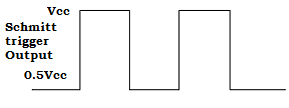
a)

b)
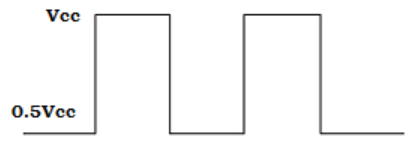
c)
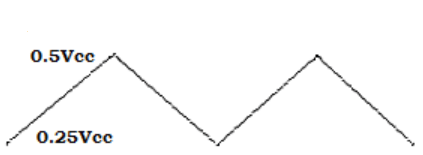
d)

View Answer
Explanation: In VCO, the output of Schmitt trigger is fed to the input of inverter. Therefore, the output at pin3 would be an inverted output. As the input is a square wave, the output obtained will be an inverted square wave.
3. Write the equation for time period of VCO?
a) (2×Vcc×CT)/i
b) (Vcc CT)/(2×i)
c) (Vcc×CT×i)/2
d) (2×Vcc)/(i×CT)
View Answer
Explanation: The time period of VCO is given as T=2×△t =(2×0.25×Vcc ×CT)/i =(0.5 V×cc×CT)/i = (Vcc×CT)/(2×i).
4. Determine the value of current flow in VCO, when the NE566 VCO external timing resistor RT =250Ω and the modulating input voltage Vc=3.25V.(Assume Vcc=+5v).
a) 3mA
b) 12mA
c) 7mA
d) 10mA
View Answer
Explanation: Current flowing in VCO, i =(Vcc– Vc)/ RT = (5V-3.25V)/250 = 1.75/250
=>i =7mA.
5. From the circuit given, find the value of output frequency?

a) 178.484 Hz
b) 104.84 Hz
c) 145.84 Hz
d) 110.88 Hz
View Answer
Explanation: Output frequency, fo =[2×(Vcc– Vc) ]/(CT×RT×Vcc )= [2x(8-1.5)]/(0.47µFx33kΩx8v) =13/0.124
=> fo=104.84 Hz.
6. The output frequency of the VCO can be changed by changing
a) External tuning resistor
b) External tuning capacitor
c) Modulating input voltage
d) All of the mentioned
View Answer
Explanation: The output frequency of VCO, fo = [2×(Vcc– Vc)]/(CT×RT×Vcc).
From the equation, it is clear that the fo is inversely proportional to CT & RT and directly proportional to Vc.Therefore, the output frequency can be changed by changing either voltage control, CT or RT.
7. Calculate the value of external timing capacitor, if no modulating input signal is applied to VCO. Consider fo=25 kHz and RT=5 kΩ.
a) 6nF
b) 100µF
c) 2nF
d) 10nF
View Answer
Explanation: When modulating input signal is not applied to VCO, the output frequency becomes fo=1/(4×RT×CT)
=> CT =1/(4×RT×fo) =1/(4×5kΩ×25kHz) = 2×10-9 =2nF.
8. What is the advantage of using filter?
a) High noise immunity
b) Reduce the bandwidth of PLL
c) Provides dynamic range of frequencies
d) None of the mentioned
View Answer
Explanation: The charge on the filter capacitor gives a short time memory to the PLL. So, even if the signal becomes less than the noise for a few cycles, the dc voltage on the capacitor continues to shift the frequency of VCO, till it picks up the signal again. This produces high noise immunity.
9. Which filter is used in VCO?
a)
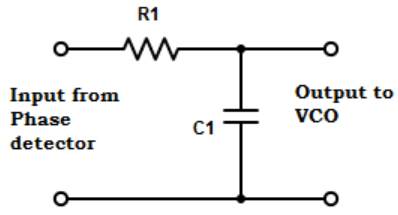
b)
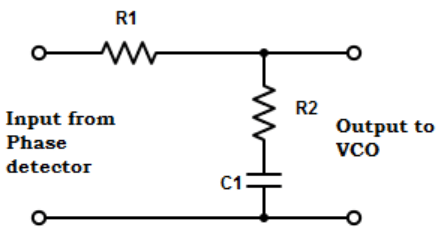
c)
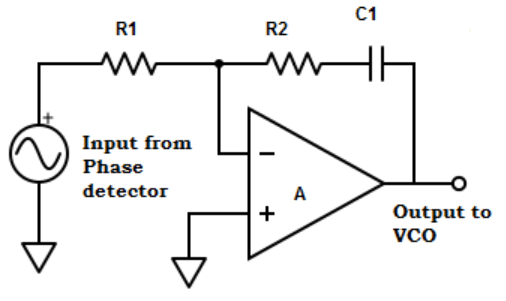
d) All of the mentioned
View Answer
Explanation: The loop filter used in the VCO can be one of the three types of filter shown above.
10. Choose the VCO for attaining higher output frequency.
a) NE566
b) SE566
c) MC4024
d) All of the mentioned
View Answer
Explanation: MC4024 is used for attaining high output frequency, because the maximum output frequency of NE566 and SE566 is 500kHz.
11. Voltage to frequency conversion factor for VCO is
a) Kv = △Vc/ △fo
b) Kv = △fo/△Vc
c) Kv = △fo × △Vc
d) Kv = 1/(△fo×△Vc)
View Answer
Explanation: The voltage to frequency conversion factor is defined as the change in frequency to the change in modulating input voltage.
=> Kv=△fo/△Vc.
12. Calculate the voltage to frequency conversion factor, where fo=155Hz and Vcc=10V.
a) 130
b) 124
c) 134
d) 116
View Answer
Explanation: The voltage to frequency conversion factor, Kv = △fo/△Vcc= 8×fo/Vcc = (8×155)/10=124.
13. Find the equation for change in frequency of VCO?
a) △fo = (2×△Vc)/(RT×CT×Vcc)
b) △fo = △Vc/(4×RT×CT×Vcc)
c) △fo = △Vc/(2×RT×CT×Vcc)
d) △fo = (4×△Vc)/(RT×CT×Vcc)
View Answer
Explanation: The original output frequency, fo =2×[Vcc-Vc+△Vc]/[RT×CT×Vcc].
The new frequency f1 =2×[Vcc-Vc]/[RT×CT×Vcc].
Change in frequency, △fo= fo– f1 = 2×[Vcc-Vc+△Vc]/[RT×CT×Vcc]-{2×[Vcc-Vc]/[ RT×CT×Vcc] => △fo = (2×△Vc)/(RT×CT×Vcc).
14. Using the given specifications, determine the voltage to frequency conversion factor.
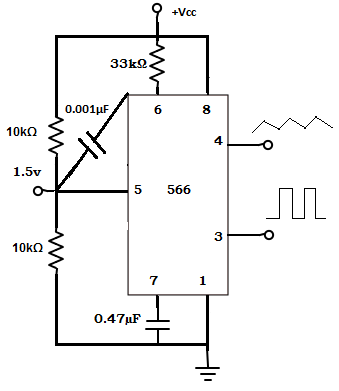
a) 8.32
b) 8.90
c) 8.51
d) 8.75
View Answer
Explanation: △fo = 2×△Vc/(RT×CT×Vcc)
=>△Vc= (△fo×RT×CT×Vcc)/2 = (4.7µFx10kΩx5x112)/2 = 13.16V.
Kv= △fo/ △Vc = 112Hz/13.16V
=>Kv=8.51.
Sanfoundry Global Education & Learning Series – Linear Integrated Circuits.
To practice all areas of Linear Integrated Circuits, here is complete set of 1000+ Multiple Choice Questions and Answers.
If you find a mistake in question / option / answer, kindly take a screenshot and email to [email protected]
